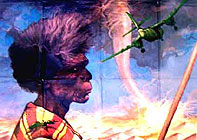|
|
|
|
Where
the Green Ants Dream
|
 |
|
Werner Herzog's Where the Green Ants Dream has been little screened or discussed since its initial release. This is scarcely surprising, since I cannot recall a single positive review of it from that time. Australian reviewers were particularly down on it – for obvious reasons. Herzog had breezed into the country with the idea of making a film around the issue of Aboriginal land rights. This in itself did not necessarily spell disaster. Herzog, however, chose from the outset to superimpose on the Aboriginal Dreaming his own personal, mythological invention of the mystical Green Ants who live within the sacred ground. His sympathies in the land rights debate were, of course, ideologically correct – white mining company reps are the butt of much heavy-handed satire in the film – but Herzog plunged headlong into a total, airheaded romanticisation of Aborigines. It is hard not to wince at the endless shots of noble blacks against the skyline – chanting, dancing, playing the didgeridoo or remaining stonily silent while some stray white sympathiser explains earnestly that Aborigines live happily beyond time, reason and the empty attractions of consumer civilisation. It is risible when Herzog goes so far as to present a supposedly corrupted black as one who wears a cowboy hat, sings a chorus of "My Baby Does the Hanky Panky", boasts that his white boss once let him play fullback in a footy team, and clutches a stubbie. I wonder what Gary Foley, the project's advisor on Aboriginal affairs, made of that when he finally saw it. Yet, at a distance of seven years, Where the Green Ants Dream really seems little different to any other Herzog film (like Fitzcarraldo [1982] or Aguirre, Wrath of God [1972]) about the entropic, mutually death-dealing confrontation of civilisation and nature. What many critics found especially clumsy in his Australian outing – the stilted dialogue, clumsy acting, lack of narrative coherence, flatly poetic sections involving landscape, machinery and classical music – are in fact the selfsame qualities that give every Herzog movie its strange, distinctive aura. As Thomas Elsaesser has argued, Herzog is best understood as a deliberate primitive of the cinema. His films celebrate those outcast individuals who are obstinate, crazy, obsessive, stolid, frankly stupid; and his own cinematic style behaves – or rather, malfunctions – accordingly. In other words, if you like your arthouse modernism a little less like Milou in May (1990) and a little more like the demented old B movies of Edgar Ulmer or Samuel Fuller, then Where the Green Ants Dream is an oddity worth experiencing. MORE Herzog: The White Diamond, Little Dieter Needs to Fly © Adrian Martin April 1991 |
![]()